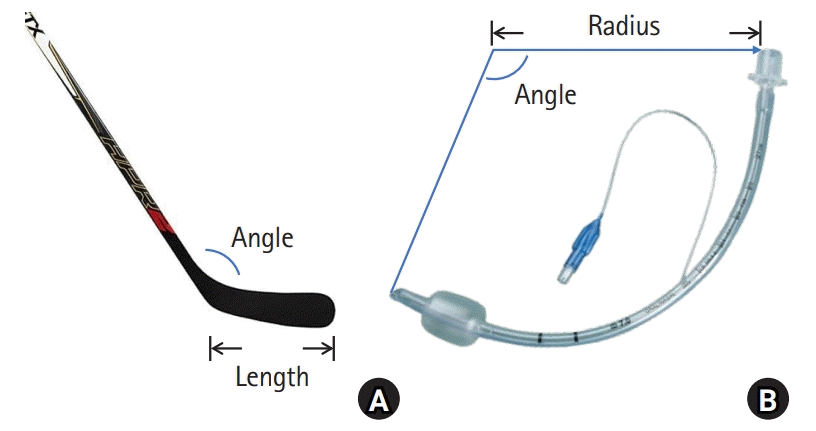See the article "Usefulness of C-curved stylet for intubation with the C-MAC® Miller videolaryngoscope in neonates and infants: a prospective randomized controlled trial" on page 433.
See letter "Response to "Comment on Usefulness of C-curved stylet for intubation with the C-MAC® Miller videolaryngoscope in neonates and infants: a prospective randomized controlled trial"" in Volume 77 on page 283.
Dear Editor,
We are intrigued by the paper titled "Usefulness of C-curved stylet for intubation with the C-MAC® Miller videolaryngoscope in neonates and infants: a prospective randomized controlled trial" [1]. However, we have specific concerns that require further discussion.
The feasibility of endotracheal intubation depends on the radius of the endotracheal tube (ETT) curvature that clinically ranges between 12.05 and 15.78 cm [2]. Technical variations may arise based on the patient’s anatomical structure, the characteristics of the laryngoscope utilized, and the proficiency of the medical provider. To mitigate these differences, the ease of ETT insertion can be adjusted by employing a stylet [3,4]. The authors describe how applying a stylet transforms the ETT into either a hockey stick-curved or a C-curved type. They suggested that in neonates and infants, modifying the ETT shape into a C-curve may reduce tube handling time compared to the conventional hockey stick-shaped tube during intubation using a C-MAC® video-laryngoscope Miller blade [1].
Generally, there are two types of Hockey sticks: field or ice hockey. Players or goalies use different shapes. Hockey players need to decide the type of curve (e.g., toe, mid, or heel), depth of curve (e.g., slight, moderate, or deep), and face angle (e.g., neutral, slightly open, or open), depending on their age, position, and preference. Similarly, anesthesiologist need to decide the angle and curve of the ETT for endotracheal intubation. We are curious about the difference between the hockey stick-curved and the C-curved type. The authors do not provide detailed explanation of the specific shape applied. Should we understand it as a general concept? We assume that the difference is only the tip of the tube that is connected to the breathing circuit being straight or curved.
The tip length of the hockey stick-curved tube or the radius of the C-curved type tube is an important aspect. We would like to know the changes in the length or angle when the hockey stick-curved tube was initially attempted and subsequently modified. Additionally, we are interested in the initial and final radius of the C-curved type tube (Figs. 1A and B). This paper does not provide clear explanation about the specific length or angle for the first attempt of endotracheal intubation. Can we conclude that the C-curve type tube is effective when using the C-MAC® video-laryngoscope Miller blade without further explanation?
Although this explanation can be understood in general concept, we guess a more detailed explanation would be helpful for clinical application. In the process of preparing for ETT, there is no explanation of the changes such as an increase or decrease in the length of the hockey stick-curved tube and/or the radius of the C-curved tube before and during intubation. In particular, the authors used a cuffed ETT; however, when using an uncuffed ETT for pediatric patients, there is also the issue of determining the appropriate point and angle of the hockey-stick shape (Figs. 1A and B). In pediatric patients, especially neonate and infants, even a slight deviation of 1 mm in the bending portion can greatly affect the difficulty of intubation in neonates and infants. The time required for endotracheal intubation is important, but so is the management of the ETT shape to ensure easy, rapid, and safe intubation. Moreover, how the medical provider holds and inserts the ETT is also crucial. With direct laryngoscopy, there is a straight pathway from the teeth to the larynx, generally allowing for a straightforward tube. While using a video-laryngoscope, we cannot see the entire length of the tube, and the ease of insertion depends on the angle of the laryngoscope blade and the length of tube tip that meets in front of the glottis. As endotracheal intubation involves exposing the glottis with a direct- or video-laryngoscope and subsequent alignment of the laryngoscope blade tip and tube tip at the glottis, differences may occur depending on the instrument type and skillfulness. Successful endotracheal intubation depends on the view of the glottis (full, partial, or none), the ease of tracheal intubation (easy, difficult, or unachievable), and the specific device used to facilitate tracheal intubation [5].
We believe that ensuring correct formation and maintenance of the shape of the ETT before endotracheal intubation is crucial for achieving easy, rapid, and non-traumatic intubation, leading to good exposure of the glottis.
Notes
Author Contributions: Dong Ho Park (Investigation; Methodology); Jong Dal Chung (Conceptualization; Formal analysis; Methodology); Chang Young Jeong (Funding acquisition; Investigation; Supervision); Hong-seuk Yang (Conceptualization; Investigation; Methodology; Project administration; Writing – original draft; Writing – review & editing)
Go to : 
References
1. Park JB, Kang PY, Kim T, Ji SH, Jang YE, Kim EH, et al. Usefulness of C-curved stylet for intubation with the C-MAC® Miller videolaryngoscope in neonates and infants: a prospective randomized controlled trial. Korean J Anesthesiol. 2023; 76:433–41.
2. Bernhard WN, Yost L, Turndorf H, Danziger F. Cuffed tracheal tubes--physical and behavioral characteristics. Anesth Analg. 1982; 61:36–41.
3. Jaber S, Rollé A, Godet T, Terzi N, Riu B, Asfar P, et al. Effect of the use of an endotracheal tube and stylet versus an endotracheal tube alone on first-attempt intubation success: a multicentre, randomised clinical trial in 999 patients. Intensive Care Med. 2021; 47:653–64.
4. Kelly FE, Cook TM. Seeing is believing: getting the best out of videolaryngoscopy. Br J Anaesth. 2016; 117 Suppl 1:i9–13.
5. Heidegger T. Management of the difficult airway. N Engl J Med. 2021; 384:1836–47.
Go to : 




 PDF
PDF Citation
Citation Print
Print




 XML Download
XML Download